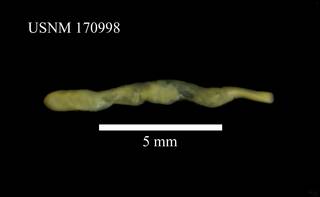
| Introduction | | Search taxa | | Taxon tree | | Taxon match | | Checklist | | Literature | | Stats | | Photogallery | | OBIS Vocab | | Log in |
CaRMS taxon detailsNephasoma (Nephasoma) diaphanes diaphanes (Gerould, 1913)
410734 (urn:lsid:marinespecies.org:taxname:410734)
accepted
Subspecies
Nephasoma diaphanes (Gerould, 1913) · alternative representation
Nephasoma diaphanes diaphanes (Gerould, 1913) · alternative representation
marine,
Not documented
Saiz, J. (2021). World Sipuncula database. Nephasoma (Nephasoma) diaphanes diaphanes (Gerould, 1913). Accessed through: Kennedy, M.K., L. Van Guelpen, G. Pohle, L. Bajona (Eds.) (2021) Canadian Register of Marine Species at: https://www.marinespecies.org/carms./aphia.php?p=taxdetails&id=410734 on 2024-04-24
Nozères, C., Kennedy, M.K. (Eds.) (2024). Canadian Register of Marine Species. Nephasoma (Nephasoma) diaphanes diaphanes (Gerould, 1913). Accessed at: https://marinespecies.org/carms/aphia.php?p=taxdetails&id=410734 on 2024-04-24
Date action by
taxonomy source
Cutler, E.B. (1994). The Sipuncula, their systematics, biology, and evolution. Cornell University Press 512 East State St., Ithaca, NY 14850, USA. ISBN #0-8014-2843-2. [details]
context source (Deepsea) Census of Marine Life (2012). SYNDEEP: Towards a first global synthesis of biodiversity, biogeography and ecosystem function in the deep sea. Unpublished data (datasetID: 7), available online at http://www.comlsecretariat.org/wp-content/uploads/2010/06/SYNDEEP-Towards-a-first-global-synthesis-of-biodiversity-biogeography-and-ecosystem-function-in-the-deep-sea-Eva-Ramirez-Llodra-et-al..pdf [details]  Present Present  Inaccurate Inaccurate  Introduced: alien Introduced: alien  Containing type locality Containing type locality
From editor or global species database
Synonymy Nephasoma (Nephasoma) diaphanes diaphanes (Gerould, 1913) and Nephasoma (Nephasoma) minutum (Keferstein, 1862) are two different species which can be differentiated when you have ripe specimens in the sample.The first species is dioecious, whereas the second is hermaphroditic. Cutler also used as a criterion the origin of the sample: deep-water for the first vs. shallow water for the 2nd species. And the 1st species is almost cosmopolitan whereas the 2nd species is restricted to NE Atlantic waters. Otherwise both species are difficult to separate since they share the same morphological characters [details] Synonymy Murina & Sorensen (2004) pp. 285-6 did not accept the proposal of Cutler (1994) and both names were considered as synonymous by them. In general: WoRMS is following Cutler (1994) proposals. [details]
To Barcode of Life (12 barcodes) (from synonym Nephasoma diaphanes (Gerould, 1913))
To Biodiversity Heritage Library (1 publication) (from synonym Nephasoma diaphanes diaphanes (Gerould, 1913)) To Biodiversity Heritage Library (1 publication) (from synonym Nephasoma diaphanes (Gerould, 1913)) To European Nucleotide Archive (ENA) (from synonym Nephasoma diaphanes (Gerould, 1913)) To GenBank (9 nucleotides; 4 proteins) (from synonym Nephasoma diaphanes (Gerould, 1913)) To NMNH Extant Collection (Nephasoma diaphanes, USNM 170998, dorsal) (from synonym Nephasoma diaphanes (Gerould, 1913)) To PESI (from synonym Nephasoma diaphanes (Gerould, 1913)) To PESI (from synonym Nephasoma diaphanes diaphanes (Gerould, 1913)) To PESI To The Arctic Traits Database (0 traits) (from synonym Nephasoma diaphanes diaphanes (Gerould, 1913)) To The Arctic Traits Database (0 traits) (from synonym Nephasoma diaphanes (Gerould, 1913)) To The Arctic Traits Database (11 traits) To USNM Invertebrate Zoology Sipuncula Collection (19 records) (from synonym Nephasoma diaphanes (Gerould, 1913)) To USNM Invertebrate Zoology Sipuncula Collection (2 records) (from synonym Nephasoma diaphanes (Gerould, 1913)) To USNM Invertebrate Zoology Sipuncula Collection (369 records) (from synonym Nephasoma diaphanes (Gerould, 1913)) To USNM Invertebrate Zoology Sipuncula Collection (Holotype USNM 98775) (from synonym Nephasoma diaphanes (Gerould, 1913)) From other sources
Hosted externally, from synonym
|
